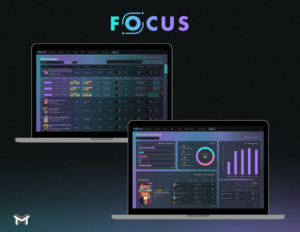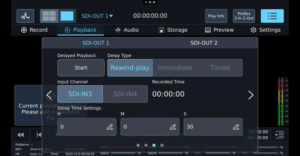October 2024
MediaTech Radar is a monthly newsletter put together by IABM’s Business Intelligence Unit. It focuses on a spotlight topic in MediaTech and reflects on a series of past, present and future business developments in the industry. In this edition, our spotlight topic is TechTracker™, the second publication of IABM’s new Tracker™ research series, which consists of three reports – GeoTracker™, TechTracker™ and ChainTracker™ – to be published in 2024. TechTracker provides a detailed analysis of trends in five key technologies that are reshaping the MediaTech landscape. The full report was published in September and can be downloaded from IABM’s MediaTech Vantage™ platform by Gold, Gold Plus and Platinum members, while an Executive summary can be downloaded by Start-Up, Silver and Silver Plus members.
MediaTech Spotlight: TechTracker™
TechTracker™ is based on comprehensive primary research, both qualitative and qualitative, as well as extensive secondary research. Five key technologies – IP, Cloud, AI, Immersive and Blockchain – are firstly viewed in parallel through a range of analytical lenses, including their relative importance in technology roadmaps, investment priorities, key drivers of adoption, challenges to adoption and synergies in technology adoption. This is followed by a deep dive analysis of market trends in each individual technology, illustrated by data from our survey of MediaTech Vendors, MediaTech service providers and MediaTech customers, insightful quotes from our interviews with industry experts and case studies that illustrate the key trends identified.
Below, we have included a selection of insights from the report:
- Cloud, AI and IP have already been adopted by a greater proportion of survey respondents than any of the other six technologies included in the survey (UHD, remote production, virtual production, AR, VR and blockchain).
- Cloud technology has become a backbone for the broadcast and media industry, offering scalable storage, content delivery and production capabilities. Cloud infrastructure is widely adopted across content production, management, storage and distribution.
- Adoption of AI is accelerating rapidly, particularly in content recommendation algorithms, automated content production, video editing and personalization. AI is transforming media workflows, but it still lags behind cloud in terms of the extent of its penetration.
- The broadcast and media industry is shifting from traditional SDI broadcasting to IP-based workflows, especially in live streaming, content distribution, and production. IP-based media infrastructures allow for faster, more flexible and scalable content delivery.
- Adoption of Cloud, AI, and IP technologies in MediaTech is highly synergistic: IP adoption provides the connectivity that lays the groundwork for integrating workflows into the cloud, cloud provides the necessary infrastructure for AI to thrive, while AI and analytics enhance the value of cloud and IP by automating and optimizing media processes.
MediaTech Watchlist: Paramount, Disney, Channel 4 and others.
- Paramount Global’s free, advertising-supported streamer Pluto TV and M6+, French TV company Groupe M6’s new AVOD platform, signed a strategic commercial and editorial partnership in September to “scale and expand their free streaming and digital businesses in France.”
- Paramount Global also initiated the next phase of its plan to lay off 15% of its U.S. workforce in September as part if a restructuring deal relating to Paramount’s merger with Skydance in the first quarter of 2025. The layoffs are focused on Paramount’s advertising group to streamline the OTA, linear business (e.g. CBS), which is in line with IABM’s findings reported in our State of the Industry report, published in September. Paramount stated in late September that “like the entire Media industry, we are working to accelerate streaming profitability while at the same time adjusting to the evolving landscape in our traditional businesses.”
- Disney lost nearly a third of a billion dollars on two Marvel movies in 2023, “Ant-Man and the Wasp: Quantumania” and “The Marvels”. Disney’s Chief Executive Bob Iger stated that because “The Marvels” was shot during the pandemic, “there wasn’t as much supervision on the set, so to speak, where we have executives there, really looking over what’s being done day after day after day.“
- In the UK, Channel 4 CEO Alex Mahon stated at the Royal Television Society’s London Convention on 17th September that digital viewers are worth more to them for advertising than linear/traditional viewership. Channel 4 expects to take 30% of ad revenue this year from digital platforms, even though viewers on digital represent only 18% of their total audience’s viewing.
- Freely’s landmark deal with Amazon in early October demonstrates how Public Service Broadcasters such as the BBC are increasingly shifting focus from linear to streaming, and from aerial/satellite to internet delivery.
- Max, Peacock and Paramount+ all account for less than 2% of US TV viewing on average; in order to compete with Netflix, Amazon and Disney, smaller players in the streaming market are considering whether to bundle, merge or go it alone.
- Streaming Pay-TV operators like YouTube TV and Fubo have seen a 77% spike in signups during NFL seasons. As long as broadcasters keep buying NFL and other major media rights, they have an incentive to extend the advertising reach of games by collaborating with vMPVDs (e.g. YouTube, Fubo) to drive viewership on FTA as well as subscriptions. However, there is now a shift towards streaming services buying exclusive sports rights, which is a major threat to vMPVD services, because it means they will have to either invest in sports rights directly themselves or become an aggregator offering access to streaming services – which are both much less lucrative options.
- Leading Korean content owners CJ ENM and NEW ID struck supply deals with Samsung TV Plus, a U.S. FAST channel, in early October as part of a rising trend for TV manufacturers to use connected TV and FAST to build their own channel brands and differentiate their sets from competitors.
- In early October, OpenAI announced raising $6.6b in funding which has boosted the company’s valuation.
- OpenAI is looking to integrate links to reputable sources into GenAI output like ChatGPT via partnership deals with traditional media/journalism brands, forming a partnership with Hearst on 8th October.
- The United Nations’ new “Governing AI for Humanity” report, published on 19th September, could significantly impact local media groups and news organizations.
- Outside of broadcast and media, AI has long shown great potential for use in scientific research. On 9th October, Co-founder and CEO of Google DeepMind and Isomorphic Labs Sir Demis Hassabis, and Google DeepMind Director Dr. John Jumper were co-awarded the 2024 Nobel Prize in Chemistry for their work developing AlphaFold, a groundbreaking AI system that predicts the 3D structure of proteins from their amino acid sequences. David Baker was also co-awarded for his work on computational protein design.
- Lionsgate partnered with Runway in mid-September to use generative AI technology as an assistive creative tool for filmmakers.
- Facebook will make its Reels content more “prominent,” as its parent company revealed its own AI video tool Meta Movie Gen in early October.
- The content creator industry could surpass half a trillion dollars by 2027, but according to Josh Helfgott, a TikTok star with more than 5.5 million followers, the industry is more competitive than ever “because everything is becoming really fragmented and really niche, while algorithms are more brutal and competitive than before.”
Thank you for reading this newsletter. If there are topics you would like us to cover or if you have information/ideas that you would like to share, please get in touch with us.
The IABM Business Intelligence Unit









